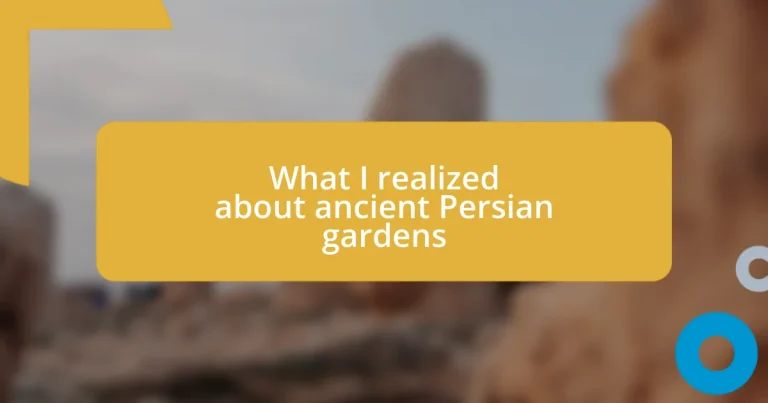Key takeaways:
- Persian gardens reflect a deep connection to nature, spirituality, and cultural values, emphasizing the significance of water, geometric patterns, and vegetation.
- They symbolize an earthly paradise and serve as communal spaces for contemplation, gatherings, and the intersection of philosophy and art.
- Famous Persian gardens, such as the Garden of Fin and Shalimar Gardens, illustrate the architectural beauty and serenity that these designs evoke, inviting personal reflection and connection to the universe.
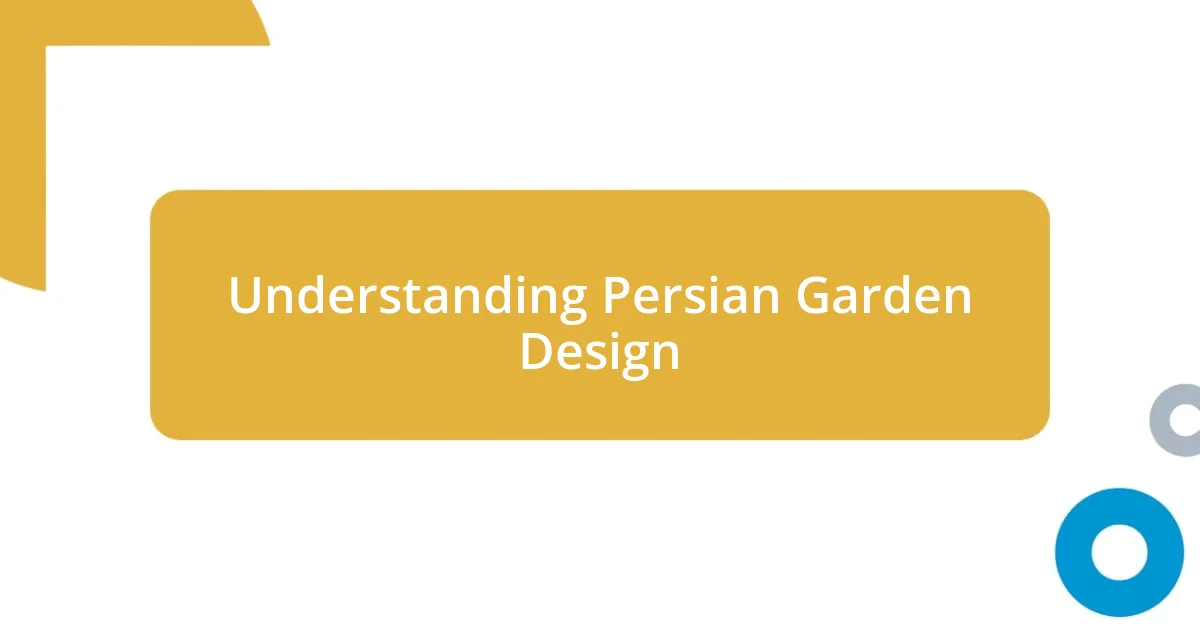
Understanding Persian Garden Design
When I first stumbled upon the concept of Persian garden design, I was fascinated by its deep connection to nature and spirituality. The layout is meticulously planned, often based on the four elements of water, earth, air, and fire. It’s a symphony of symmetry and serenity, inviting you to experience beauty in every corner.
One thing that truly struck me is the emphasis on water features. In these gardens, water often represents life and is intricately designed to flow through the space, creating a soothing ambiance. Just picture yourself sitting by a serene fountain, listening to the gentle trickle of water while absorbing the vibrant colors around you. Isn’t it remarkable how a simple concept like water can invoke such profound feelings?
Looking at the typical layout, I can’t help but admire how the use of geometric patterns reflects the Persian worldview. The gardens often consist of square or rectangular plots divided by pathways, symbolizing the universe’s order. It’s as if each step you take through these meticulously crafted spaces reminds you of harmony and balance—aren’t we all in search of such tranquility in our own lives?
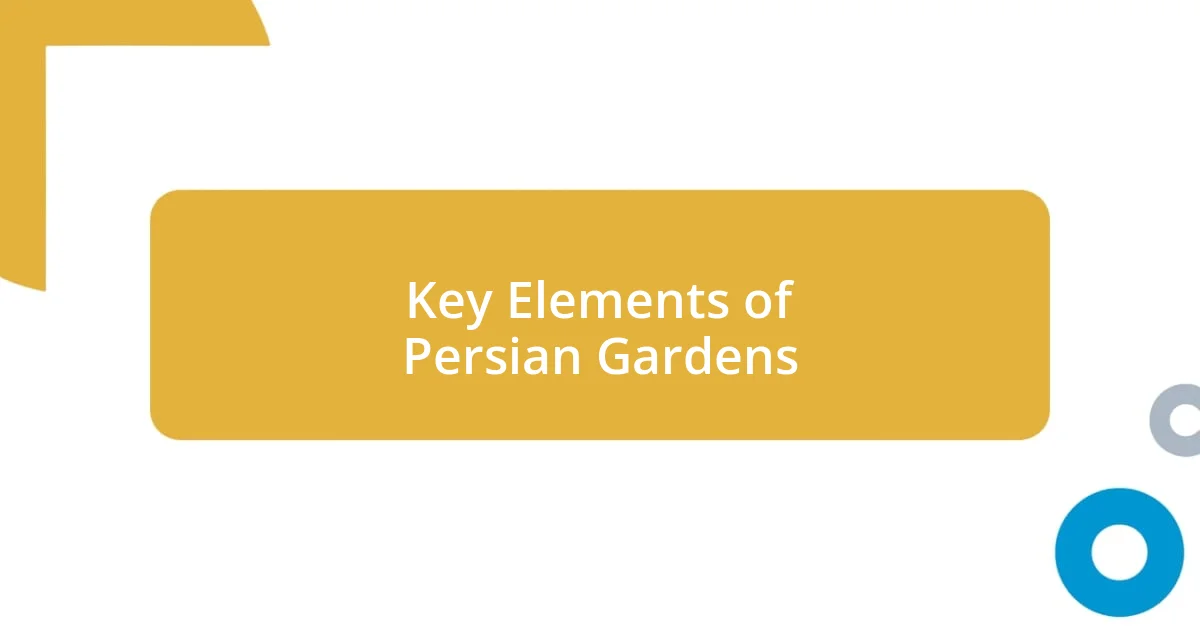
Key Elements of Persian Gardens
The first key element that stands out in Persian gardens is the meticulous use of water. I remember visiting one of these gardens and being struck by the gentle sounds of flowing water, which instantly calmed my mind. Water serves not only a practical purpose, creating microclimates and nurturing plant life, but it also embodies life’s essence—an idea deeply embedded in Persian culture.
Equally important are the geometric layouts that define these gardens. The solid lines and symmetrical designs created a sense of order, which I found incredibly soothing. As I walked along the pathways, I began to appreciate how each bend and turn feels intentional, guiding you toward a harmonious experience that reflects both nature and human artistry.
Finally, the strategic placement of trees and plants cannot be overlooked. The lush greenery provides shade and respite, but it also speaks to a deeper connection to nature. I often found myself sitting beneath a sprawling tree, feeling nature’s embrace—it’s an invitation to pause and reflect, something we often forget to do in our busy lives.
| Element | Description |
|---|---|
| Water | Symbolizes life, providing a soothing ambiance and cooling effect. |
| Geometric Layout | Represents cosmic order and induces a sense of tranquility. |
| Vegetation | Offers shade and a connection to nature, fostering reflection. |
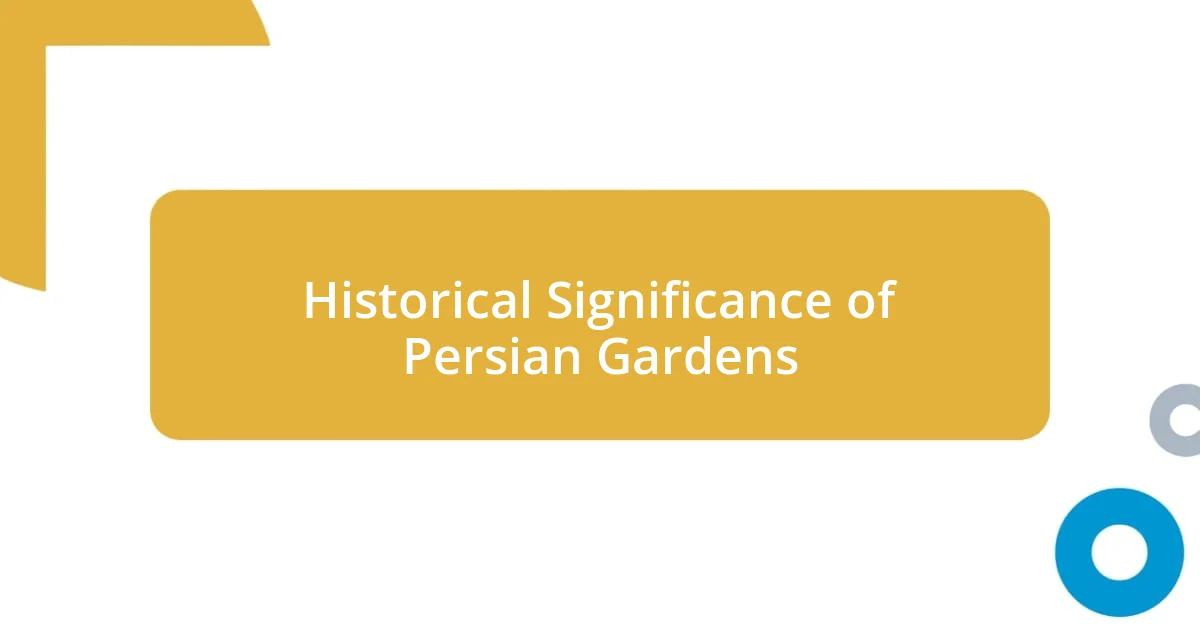
Historical Significance of Persian Gardens
The historical significance of Persian gardens goes beyond mere aesthetics; they serve as a representation of the cultural and philosophical values of ancient Persia. When I first explored one of these gardens, I was struck by the sense of serenity and contemplation they evoke. It was as though I stepped into a space where time stood still, allowing me to connect with centuries of history and tradition. These gardens were often constructed as paradises on Earth, embodying an idealized vision of nature that Persian poets often celebrated in their verses.
- Symbol of Paradise: Persian gardens symbolize an earthly paradise, showcasing the civilization’s desire to replicate the beauty of nature.
- Cultural Influence: They reflect the rich philosophical underpinnings of Persian culture, emphasizing balance, contemplation, and the relationship between humanity and nature.
- Historical Legacy: The design and concepts behind Persian gardens have influenced garden design across the globe, shaping how we view nature and tranquility today.
Walking through these spaces, I learned that gardens were also venues for gatherings, discussions, and celebrations—an integral part of community life in ancient Persia. They weren’t just places to enjoy beauty; they were living classrooms where philosophy and art intertwined. Each corner seemed to whisper stories of universal truths, making me appreciate the gardens not just as beautiful landscapes, but as vital threads woven into the fabric of Persian heritage.
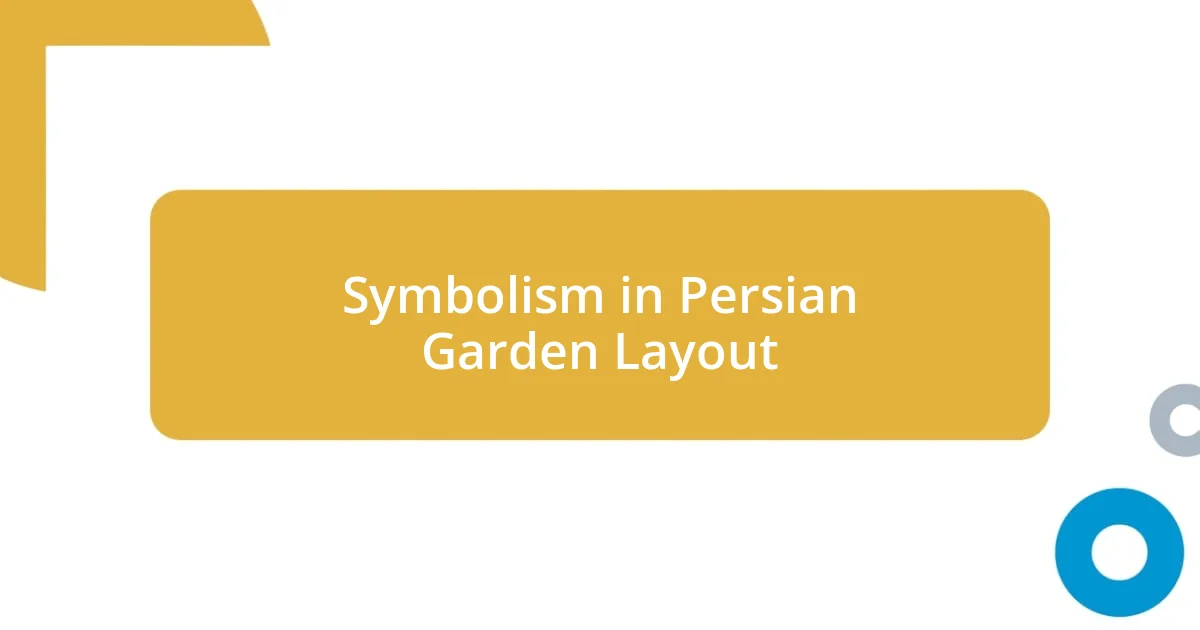
Symbolism in Persian Garden Layout
The layout of Persian gardens is not merely functional; it symbolizes the duality of nature and human creativity. As I wandered through one such garden, I noticed how the carefully arranged sections resembled a microcosm of the universe. It dawned on me that each quadrant wasn’t just an aesthetic choice, but a representation of the four natural elements: earth, air, fire, and water. Have you ever paused to consider how garden designs can echo our deepest beliefs about life?
Moreover, the division of space within these gardens often serves as a metaphor for the human experience itself. I recall watching people meander through paths that led to small, intimate alcoves, each one offering a pause for reflection. This subdivision creates a sense of journey, mirroring the trials and triumphs we all face in life. Isn’t it fascinating to think that each twist and turn in the pathway invites momentary contemplation, inviting us to reflect on our own journeys?
Finally, the interplay of light and shade within the garden layout is also deeply symbolic. During my visits, I found myself captivated by how sunlight trickled through the branches of carefully placed trees, creating a dance of light and darkness on the ground. It felt like nature was commenting on the balance of joy and sorrow in life. How often do we contemplate the significance of light in our lives? In these gardens, light becomes a metaphor for hope, while shadows remind us of life’s complexities, striking a harmonious balance that resonates deeply with our own experiences.
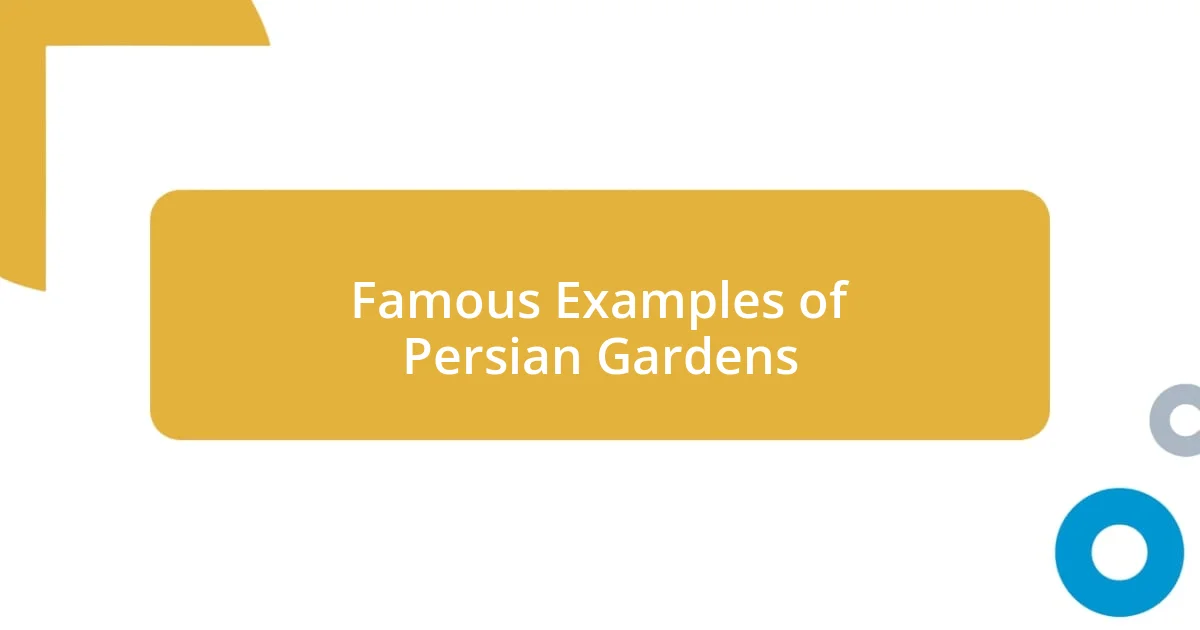
Famous Examples of Persian Gardens
One of the most renowned Persian gardens is the Garden of Fin in Kashan, which I’ve had the pleasure of visiting. As I stepped inside, the meticulously planned symmetry struck me immediately. It’s like entering a realm where every tree, fountain, and path tells a story. The soothing sound of water cascading through the channels provided a serene backdrop, reminding me of how nature nurtures our sense of peace. Have you ever found a place that just wraps you in tranquility? This garden embodies that feeling perfectly.
Another example is the famous Shalimar Gardens in Lahore, which reflect the artistic ingenuity of the Mughal era, influenced by Persian designs. When I strolled through these expansive grounds, the vibrant colors and fragrant blooms felt like an invitation to explore my inner world. I couldn’t help but marvel at how these gardens served not just as leisure spaces, but as serene sanctuaries for thoughtful visitations and connection to nature. Every corner revealed a new perspective, making me wonder how many deep conversations had been fostered under the cool shade of those ancient trees.
Then there’s the splendid concept of the Persian Paradise Garden, or “Chahar Bagh,” which translates to “four gardens.” The layout itself, divided into quadrants, resonates with harmony and balance that I found deeply moving. While walking these paths, I felt an innate connection to the universe. It’s fascinating to consider how these designs, representing the essence of life, have traversed time and geography. Have you ever experienced a garden that speaks to your soul? In these Persian examples, I certainly have, as they convey the universal quest for beauty and serenity.












